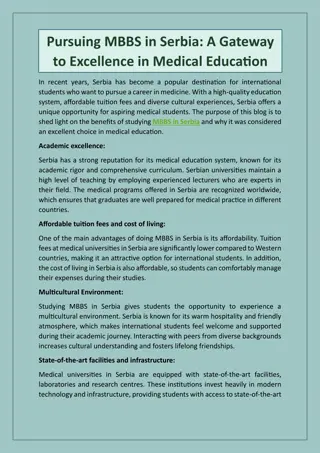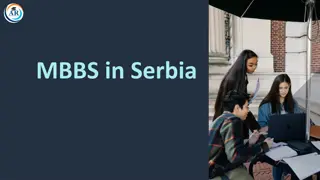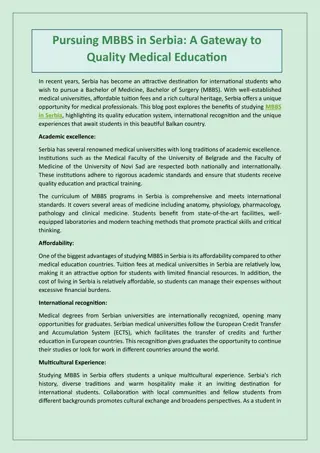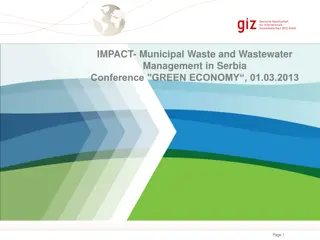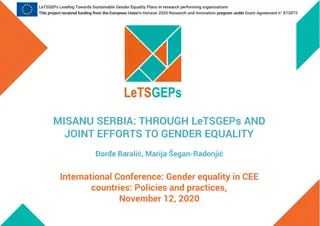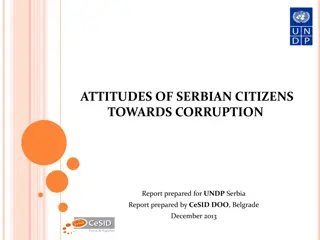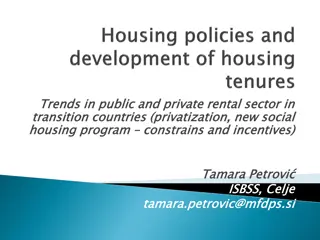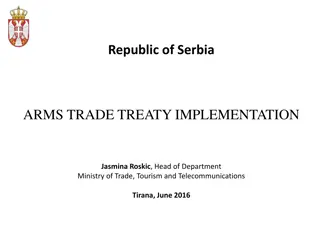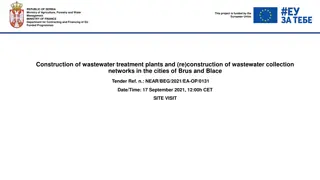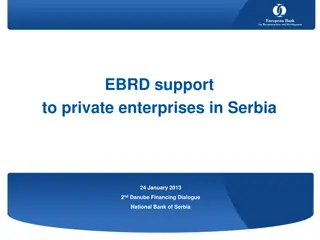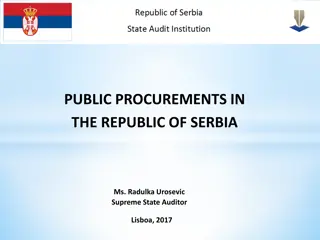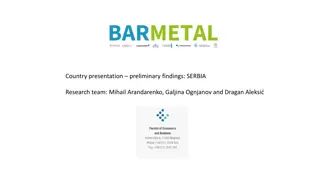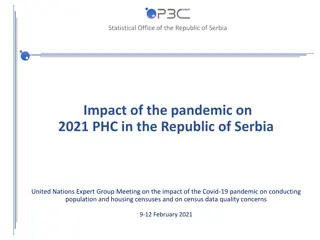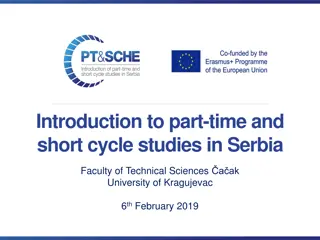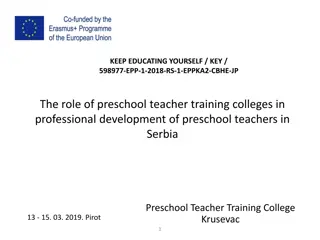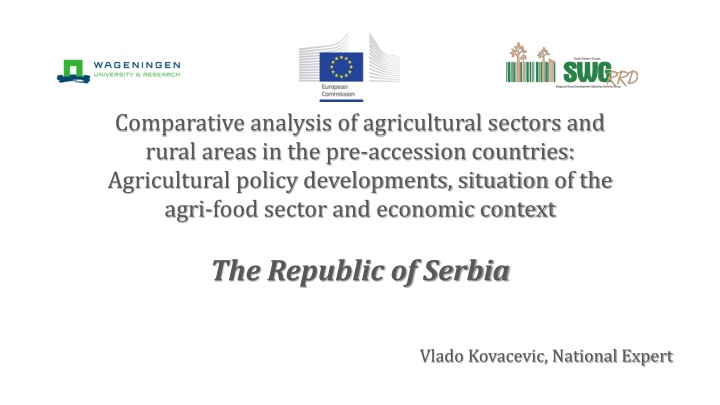
Analysis of Agricultural Sectors & Rural Areas in Republic of Serbia
"Explore the agricultural policy developments, challenges, budgetary support, and policy changes in the agrifood sector of Serbia during 2020-2021. Learn about the impact of COVID-19, green policies, and the EU association process on Serbian agriculture."
Download Presentation

Please find below an Image/Link to download the presentation.
The content on the website is provided AS IS for your information and personal use only. It may not be sold, licensed, or shared on other websites without obtaining consent from the author. If you encounter any issues during the download, it is possible that the publisher has removed the file from their server.
You are allowed to download the files provided on this website for personal or commercial use, subject to the condition that they are used lawfully. All files are the property of their respective owners.
The content on the website is provided AS IS for your information and personal use only. It may not be sold, licensed, or shared on other websites without obtaining consent from the author.
E N D
Presentation Transcript
Comparative analysis of agricultural sectors and rural areas in the pre-accession countries: Agricultural policy developments, situation of the agri-food sector and economic context The Republic of Serbia Vlado Kovacevic, National Expert
Overview of the Analysis Policy framework including changes in policy in the last two years; The main challenges in Serbia from economic, environmental and structural aspects of agriculture; The budgetary support of agriculture and rural development (based on the APM data); New policies in 2020/21 and IPARD II and IPARD III programmes; COVID-19 interventions; The green policies implementation in 2020/21; The EU association process.
Specificity of the period 2020-2021 The last two years are not comparable fully with the previous period due to: COVID-19 pandemic exceptional policy measures as a county s reaction; Market supply and demand disruption due to pandemic; The CAP reform in 2021 orientation toward green policies ; Growing prices of food and inputs (fuel and energy especially) on the world market;
Serbian agriculture in numbers Number of holdings 564 541 Agricultural land 5.2 mill. ha Utilized agricultural area (UAA) 3.5 mill. ha Average UAA per holding 6.2 ha Livestock units 1.9 mill. Share in total GVA 11.3% Positive trade balance of Ag & food products 1.8 bill. EUR
Agricultural and RD policies in Serbia in 2020/21 Increase the budgetary support for agriculture and RD; Growth of subsidies in animal production; Exceptional intervention measures due to COVID-19: Establishing the legal framework for the introduction of CMO; Steps toward digitalization and green policy ; The new trade agreements (EEU, UK and Open Balkan ); Realization of the IPARD II Programme; Adoption of the IPARD III Programme by the EC; Slower EU integration process.
Major changes in policy instruments Increased direct payments: direct payments per head (cattle mostly); milk premium (payments per output); New RD support measures for competitiveness improvement: investments in building facilities and procurement equipment in the wine and spirit sectors; investments in field electrification; investments in the procurement of new tractors; achieving quality standards through wine and brandy quality improvement; investments in rural infrastructure; IPARD II M1, M3 and M7. Established legal framework for CMO instruments.
Main characteristics of Ag & RD policies Shifting direct support towards direct payments per ha/head by cancelling input subsidies; Unproportioned support to the livestock sector in comparison to the crop production; RD support aimed almost fully at competitiveness improvement with insufficient support for environmental and rural economy measures; Decoupling of direct payments is still pending.
IPARD SUPPORT Overview of the measures, funds and number of applications in IPARD 2014-2020 Indicator M1 M3 M7 M9 Total No. of applications 1 604 313 604 0 2 521 No. of approved applications 680 100 54 0 834 EU contribution (th. EUR)* 39 200 21 000 5 800 0 66 000 National contribution (th. EUR)* 13 100 7 100 1 900 0 22 100 Total payments (th. EUR)* 52 300 28 100 7 700 0 88 100 EU allocated amounts (th. EUR) 97 472 49 327 26 200 2 000 175 000 * Data for approved projects (as of 31st December 2021) Source: The Annual Report on the implementation of the IPARD II Programme for 2021
Comparison with the CAP All direct payments are coupled; Cross-compliance is not a precondition for receiving payments; IACS/LPIS is not in place; Definition of active farmer is not harmonized; Some EU ineligible sectors are supported under direct payments (pigs, poultry, beehives, fish); Some measures close to the Green Deal and Farm to Fork Strategy are implemented already (risk management, conservation of genetic resources, organic production, soil control and land quality improvement);
EU accession process Opening benchmarks for Chapter 11: 1) Serbia presents to the Commission an action plan, which will serve as a basis for the transposition, implementation and enforcement of the acquis in agriculture and rural development; 2) Serbia has submitted the request for entrustment with budget implementation tasks for IPARD II to the Commission, in accordance with the provisions of Commission Implementing Regulation 447/2014. Both opening benchmarks are fulfilled; OBAR by the EC still pending; Preparation of the Negotiating position is in progress.
Conclusion and recommendations Serbian agriculture is characterized by overall slow growth. One of the biggest obstacles is the small farm size structure and lack of cooperative activities. Small farms not organized in cooperatives are with high production costs, low marketing barging power, etc. The second important characteristic is the uneven development of farms all over the country. Yields are lagging significantly behind the EU average. Only 2% of agricultural land is under irrigation, which places Serbia in the last place in Europe. Agriculture is a rare sector in the Serbian economy with a positive foreign trade balance. The structure of exports is not optimal since exporting of high- value processed products while imports are dominated by primary agricultural products, while most of the exported products are high-value processed agricultural products. The current policy framework has a strong emphasis on direct support per area and animal, and it funds rural development measures only modestly etc.
Conclusion and recommendations 1) Further shifting of the budget structure by decreasing direct payments allowance in favour of the rural development measures. 2) Subsidies for organic production are based on the measures for convectional production (adding a percentage amount on the support in conventional production). Organic production measures need to be decoupled from conventional production support, as an organic sector has different requirements. 3) Small dairy processors making dairy products at their own are excluded from the milk premium scheme. Only producers selling milk to dairies are eligible for subsidies. A potential pathway may be the Montenegro example where all small milk processors enrolled in the Registry of small dairy processors are being paid per milking cow fix amount. 4) Introduction of milk premium based on milk quality.
Conclusion and recommendations 5) Georgical indications should be oriented toward EU designation. This is concerning in all Western Balkans where there is no single product registered within the EU. Individual registration with a national mark is proven to be unsuccessful in all WB countries. The first step is to harmonize national legislation with EU acquis and promote EU designation. With this strategy in place, numerous national GEs marks will be replaced with one EU. 6) Ban on GMO products is one of the most important limitations for the Serbian livestock sector. Serbian producers are not allowed to use GMO feed and as a consequence production is more expensive, on the other hand, imported animal products produced by GMO feed are imported freely in Serbia. This creates unfair conditions for the Serbian livestock sector. The solution can be found in two directions. First to allow GMO production or second to introduce an effective National Non-GMO animal products quality scheme which will allow labeling of animal products without GMO use and create a possibility for higher pricing.
Conclusion and recommendations 7) To create conditions for removal of swine meat EU export ban. Serbia is not permitted to export swine meat nor to transport swine meat throughout the EU due to the swine plague. The first step toward this goal is taken, vaccination against this disease is stopped. The second step is in the introduction of a Veterinarian indemnity fund or other compensation schemes which will compensate farmers in the case of necessity for animal eradication. The main purpose of compensation schemes is to motivate farmers to report suspicion of dresses. 8) Phytosanitary, Veterinarian and Agricultural inspections to introduce inspection based on risk analyses based on EU practice. 9) Establishing the stimulating legal framework for agricultural associations is one of the most important milestones for the improvement of the Serbian agriculture competitiveness. Agricultural cooperatives in number, activity and assets are lagging behind the EU tens of times. The biggest barrier to cooperative development is the inadequate legal framework. Serbia is among few countries in the world with cooperative ownership as a third type of ownership defined in the Constitution of the Republic of Serbia, creating uncertainty among cooperative members in relation would whether their cooperative shares be at their full disposal.
Conclusion and recommendations 10) Support producers' associations to be long-term predictable and only for real cooperatives doing business with their members. Current support for cooperatives is ad-hoc and rare. Cooperatives are needing long-term predictable structural support. A good example could be found in the EU, like Italy where agricultural cooperatives having business in more than 50% of their members are receiving tax reliefs. This approach could avoid the establishment of associations just in the purpose to receive support, without any other mission, which has often happened in the previous period. 11) To abandon the current statistical classification of settlements by type (urban and other) and apply the area classification for the NUTS 3 area level according to the accepted urban-rural typology of EC and Eurostat. For SORS to classify the spatial units for the municipal level (LAU 2) according to the degree of urbanization, in accordance with DEGURBA methodology, which is expected after the 2021 Census of population, households and dwellings. See Appendix 1 of the Report. SORS - Economic accounts of agriculture establish statistics to include monitoring of Labour Consumption in Agriculture in AWU. A Farm Structure Survey should be carried out in the inter-census period every 3 years.
Conclusion and recommendations 12) The Farm Register improvement: as the main database for the policy implementation, the Farm Register needs to be structured at the most detailed level with a possibility for data cross-checking and obtaining timely information for decision making. The annual renewal of registration must be mandatory, regardless of whether the parameters of production or the farm status change. Promotion and awareness-raising on the advantage of registration would lead to an increased number of registered holdings. 13) Development of risk management instruments in agriculture. Serbia is among the last countries in Europe regarding agricultural insurance. Estimation is that only 5% of parcels are insured. Recommended measures are: improvement in hydrometeorological data, coupling subsidies with mandatory insurance of the subsidy's investments (often successful practice in EU and USA), appointing a central organization in charge of collecting the data on agricultural insurance, the introduction of new technologies important for area biased insurance and so on.

